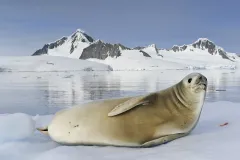Life in the Field

To a photographer, all that matters is the image, the picture that results when the shutter is released. This is what people will see and what will remain of that moment in time, captured forever. But for wildlife photographers and especially underwater wildlife photographers, so much has to happen just to get to that moment when your finger is on the shutter release.
Underwater photography is an equipment intensive business. It requires all the equipment used by land photographers, plus so much more. Cameras must be placed inside underwater housings and special strobes, strobe arms, cords, housing ports and extension rings are needed as well, plus cases full of lenses. Then there is all the diving gear - wetsuits of varying thicknesses, drysuits, masks, snorkels, fins, regulators, buoyancy compensators and more.
Because I often work in remote locations where I cannot buy specialized items I might need or get equipment repaired, I must bring back-ups of everything, plus an assortment of tools. In total I often head off on assignment with thirty cases of equipment in tow. On many assignments I bring movie lights with hundreds of feet of cable to be powered by generators on boats above and an array of other supplemental lights as well. I sometimes envy my street shooting colleagues that travel with only two or three camera bodies and a handful of lenses. But then again, they don’t get to spend months with sharks or sea turtles.
I have often mused that being a National Geographic magazine photographer is not unlike being a professional athlete, in that you are only as good as your last game or in my case, my last story. The magazine expects results and a photographer cannot have failures and continue to expect assignments. There are so many things that must go right for success and inevitably things always go wrong. Learning to overcome problems is key to success and problems come in all shapes and sizes, from luggage not showing up to equipment malfunctions. Then of course there is Mother Nature, with variables you simply can’t control from bad weather to poor visibility to animals just not being there.
Knowing that there are so many things I cannot control, I dedicate as much time as possible working on the things I can control. Detailed research is crucial, because I need to know as much as I can about my subjects and locations. I want to know where and when can they be found, if the water will be clear enough for pictures and what behaviors might I be able to document. Once I have the assignment, I adopt a mindset in which failure is not an option. The job has often been called a zero mistake game; fail to deliver the goods and you are done. With this always in mind, I’ve learned to become good at research and good at solving problems.

